Cold and warm colors color type. Dark coloring of appearance: color types dark winter and dark autumn
Determining your true color type is a very important step towards creating the perfect wardrobe. If we know our color type, then we can unmistakably choose the colors of clothes that will adorn us. An article was devoted to this topic, and each color type was discussed in detail in.
I get a lot of questions in the mail regarding the details of defining my color type, so I will try to supplement what has already been said and dwell on this issue in more detail.
Color characteristic
Before understanding the color types, it is necessary to understand what characteristics the color itself has.By Munsell color system any color can be described using three numbers (three leading characteristics):
- his color tone(warm or cold tone)
- lightness / depth (deep, that is, a dark shade or light)
- saturation (bright or muted).
Let's take blue as an example. True blue stands on the border between warm and cold. All shades removed from it by color wheel() towards violet are cold, and blues towards green are warm.
blue is light shade blue, and dark blue - its, respectively, a dark, deep shade.

Ultramarine is bright shade blue, and the blue color of natural topaz is muted, soft.
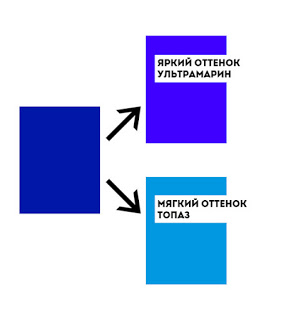
Another example with red and its shades. Raspberry - cold, tomato - warm. Scarlet is light, and wine is dark, deep. Fuchsia is bright and dusty rose is muted. That is, everything is quite simple.

Method for determining the color type according to 6 color characteristics.
Having dealt with the Munsell system, you can safely apply it to your own natural colors. There are three elements to consider here: natural hair color, natural eye color and skin color.Our natural colors will have the same characteristics as any color: they can be dark, saturated or light, or have a medium saturation. They can be clean, bright or muted. They can be either warm or cold.
Our task is to determine leading characteristic, that is, which of the above (warm-cold, deep-light, bright-muted) is most pronounced in our natural colors.
I'll give you an example. You have blond hair, gray eyes, and medium skin tone - fairly fair, but not very pale.
You will start from the first pair - warm and cold. It is difficult for you to determine what is warm and what is cold. Means, this pair is not leading in your case You may not have a pronounced temperature (warm or cold), or you may also have a mixed (neutral) temperature.
Go ahead, take the second pair - light and deep. You don't come across as very "light" or very brunette. You are somewhere in between: blonde hair - neither dark nor light, etc. Again, this characteristic is not leading.
Finally, move on to the third pair - bright and muted (low contrast). Look for contrast in your appearance: there is none. Eyes, hair and skin are about the same saturation - medium.
This is your key characteristic: lack of contrast. Thus, you have determined your color type - Soft or Muted.
Since there is no contrast in your appearance, it will not look organic in clothes either. You're better off with low contrast prints as well as medium saturation colors - not too bright (so they don't contrast with your appearance) and not too dark or light.
Another example: you have dark eyes, hair and dark skin.
This is what is yours key feature: the colors of your appearance are saturated, dark.
Move on to another pair: warm or cold temperature of your paints. Are you sure that yellow and orange look monstrous on you, like any warm colors. You have clearly cold colors of appearance.
Third pair: bright or muted. You have pure brown eyes, rich hair color - you can’t call muted colors of your appearance. So you have pure colors.
Thus, you conclude: your main characteristic is the depth of your colors, which means that you belong to the Deep color type, that is, saturated deep colors suit you best.
Add your other characteristics here: these colors should also be cold and clean (not muted).
That's how it works. The six color types below are given as general guidelines for convenience only, but remember that each color type has your own. personality traits: that is, it is best to focus on your own exterior paints and ALL of their characteristics.
The bottom line is that we look most organically in those clothes that are combined with our natural colors and their characteristics.
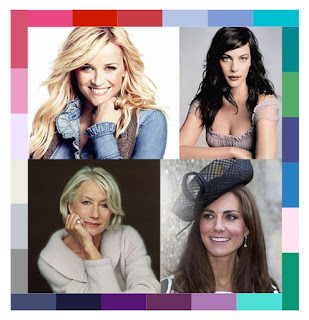
If all three components (skin, hair, eyes) have cold shade, then you belong to . If you are a blonde, then your hair is ashen, or your hair has a silver tint, if you are a brunette, then your hair does not contain reddish or chestnut shades, it is rather black. If brown-haired, then the hair is also with an ashy tint.
Eye color is cold: pale blue, steel gray, light gray, gray-green, green cold, and also dark brown.
Your skin is either light (it has a pinkish cold tint, a pink blush that fades into blue) or dark (olive). You are a representative Cold color type only if the color of the skin, eyes and hair contains cold shades. .
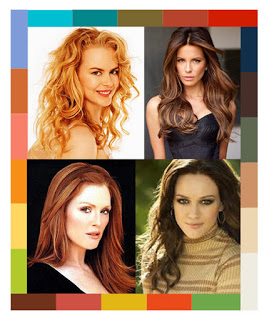
If all three components have a warm tint, then you belong to. If you are a blonde, then strawberry, your hair is golden, if you are a brunette, then with a chestnut tint, if you are a brown-haired woman, then your hair also has a golden or chestnut, reddish tint. If you are a natural redhead, then this is definitely also a warm color.
Eye color is warm: light brown, golden, hazel, yellow, warm green, khaki, greenish brown, warm blue or blue and warm gray (this also happens).
The skin is either dark (peach) or light with a peach or yellowish tint, the blush is also peach, leaving in yellowness (not blue). Skin tends to be warm if freckles are present. You are a representative Warm color type only if skin, eye and hair color contains warm undertones. About,
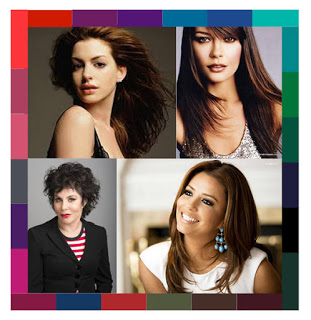
If you have dark eyes (brown, dark gray, dark green, brown-green) and dark hair, while the skin can be either dark or light, and your natural colors are dark, saturated, then dark or saturated colors will look better on you than their bright counterparts.
In this case, you are a representative. About, .
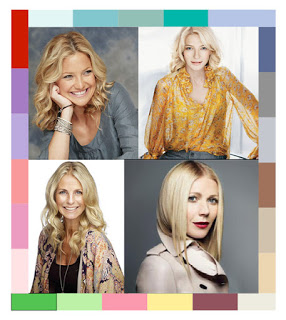
If, on the contrary, eyes, hair and skin you rather light then you belong to, that is light or bright colours will adorn you. Representatives of the Light color type are not necessarily blondes, they can also be brown-haired women with fair skin and light eyes. You belong to this color type in case they don’t suit you dark colors. About,
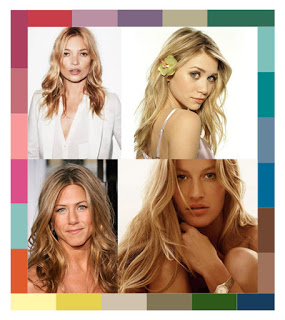
If there is monochrome in your appearance, that is, all three components, the color of eyes, hair and skin, do not differ much in tone, they are not too light, but not too dark, and also similar in color, then you are a representative.
If the hair is blond, then it is more of a dark blond, and not bright or very light, if the hair is light brown, then it has a grayish tint, and not a rich chestnut brown. Also hair can be golden with golden skin and hazel/yellow eyes.
You are not a brunette, that's for sure. That is, hair color varies in the range of medium tones. (Kate Moss, a representative of this color type, has a grayish blond hair color (mouse) by nature, she is a dyed blonde).
Eye color: gray, gray-green, gray-blue, light brown, golden, hazel, yellow-green, etc. It's not bright, it's muted.
The skin is also of medium tone, not very light, but also not dark.
About, .

If there is a contrast in your appearance between all three components: the color of the eyes, hair and skin, then you are a representative. Skin color - very pale, very light, despite the fact that the hair color is naturally quite dark. You are either dark brown or brunette.
Eye color bright: blue, green, sea wave. The color of the eyes should be different from the color of the hair (that is, the eyes are not brown).
About, .
If we wear colors that are close in characteristics to our natural colors, we will look fresher, younger and more harmonious.
Other color type determination systems
There is a widely known seasonal method, i.e. Winter, Spring, Summer, Autumn. To be honest, I do not quite agree with him, since he is not always accurate, which means that he is not suitable for everyone. The fact is that this method a priori assumes that two color types, Summer and Winter, are cold, and the other two, Autumn and Spring, are warm. Summer and Spring are light, and Winter and Autumn are saturated, dark. But, after reading all of the above, you yourself have seen that it is best to take into account also the contrast in appearance, and the purity / muffled colors too.And this method does not take into account the entire set of these characteristics.
Apparently, many asked this question, and invented a more detailed Seasonal system of 12 color types, which is a hybrid of the Seasonal method and the 6 color types method described above. According to this advanced system, Summer is Cold, Light and Mild, Autumn is Warm, Deep and Mild, Winter is Cold, Deep and Bright, and Spring is Warm, Bright and Bright. As you can see, it's easy to get confused here!
Which method to use, choose to your taste, but I suggest simplifying your life, and try using color type determination method based on 6 leading characteristics. It really works and is quite simple. Using this system, you just need to understand which of the three color characteristics dominates your appearance: you are either too light or have saturated dark colors, your appearance is either contrasting or monochrome, your colors are either overtly warm or cold.
I hope this article helps you figure out which color type you relate. And this, of course, will help you choose clothes that most favorably emphasize your personality. natural beauty. It is possible that you will discover new palette which has never been used before. And what could be better than pushing boundaries and expanding opportunities? This applies not only to clothing, but also to jewelry. Follow this link if you want to know.
Dear readers! All about compiling capsule wardrobe and about building a wardrobe tailored to your color type, read the following articles, write your suggestions, ask questions and subscribe to the news.
This article is a continuation of the topic about the 12-season color typing system. To take an online test and find out your color type, as well as read about the 12-season system, you can look at the introductory article -.
We recently took a closer look at light coloring. Today, according to the same scheme, we will get acquainted with the opposite light dark color. It is divided into two color types - dark winter, which belongs to the cold type, and dark autumn, which refers to warm.
dark color
What you need to know about dark color:
- these are deep and saturated colors;
- predominate in color dark tones;
- the colors of the palette contain black, so they look so thick and heavy;
- via dark colors many shades of mood can be conveyed - from confident dignity and strength to gloomy melancholy.
Now we will consider a dark winter and a dark autumn. We will see photos of people of this type of appearance. Let's analyze the palette into groups - light and dark colors, colors of medium saturation and bright colors. Then we will learn how to combine these colors with each other, and find out the best combinations for each color type. A picture will also be attached for associative connection with the color type. At the end of this article, we will compare both types, see how they differ. So let's get started!
dark winter
Other names:
deep winter
Color characteristics:
leading - dark, additional - cold
Associations:
deep, cold, mysterious, closed

El Greco "View of Toledo"
In the appearance of people of dark winter, dark and cold tones predominate. As a rule, there is a contrast in the colors of the exterior that needs to be repeated in clothes. Hair color is dark. Cold skin tone. Eye color is most often dark brown. You can meet the green color of the eyes, but there will still be a cold tone.
I want to draw your attention to the fact that it does not matter whether the color type is suitable or not according to the description. And, of course, you do not need to focus only on photographs. Be sure to check this by applying different fabrics, scarves, scarves to your face. It is necessary to observe how the complexion changes on different colors when it starts to fade, and when it shines. And thus you can find your color scheme. All color types have their exceptions. For example, you can be a blonde with blue eyes, and be a winter type. Therefore, everything needs to be tested in practice.
Photos of people whose color type is dark winter: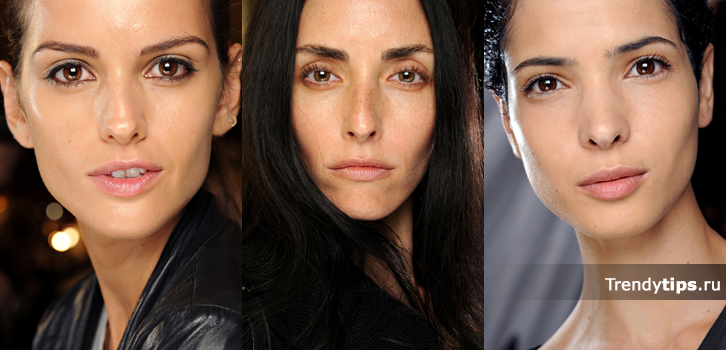

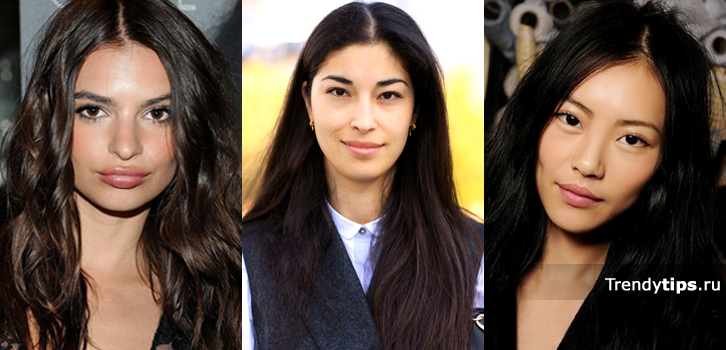
Now let's analyze the palette for a dark winter.
All colors can be divided into 4 groups:
- light;
- dark;
- colors of medium saturation;
- bright.
Light colors
Light colors are suitable for underwear, blouses, summer and evening wear. They are good to use in combination with dark colors, then you get a contrast in lightness. 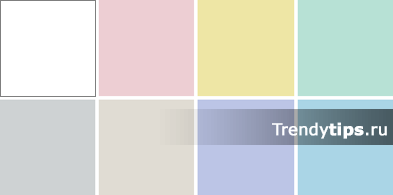
dark colors
Dark colors are good for everyday and business clothes and also for accessories. For this color type big choice dark, saturated colors. These are the "native" colors for the dark color. If you pay attention, then there is a black color in the palette. People with a dark winter color type do not need to try to “pacify” and “tame” him, because he suits them. 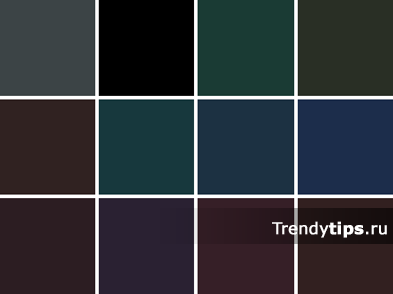
Medium saturation colors
Suitable for basic clothing. By themselves, they are not the best for dark winters, but they work well with other colors, and serve as a bundle for a set. 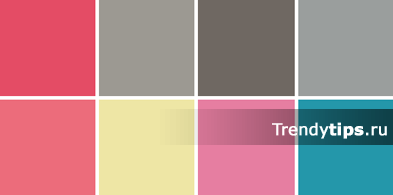
Bright colours
Bright colors are used as accents, in accessories, evening dresses. Colors from this group look very good in sportswear.
Now, with the help of the dark winter palette, let's try to combine things. Polyvore is suitable for experiments (website www.polyvore.com). There you can combine different things, there is a search by color, you can find collages with combinations that other people have made.
To learn how to combine colors well, I advise you to read interesting article on the site - " ".
The overall color effect for a dark winter should be medium-dark to dark. The contrast in lightness also looks good.
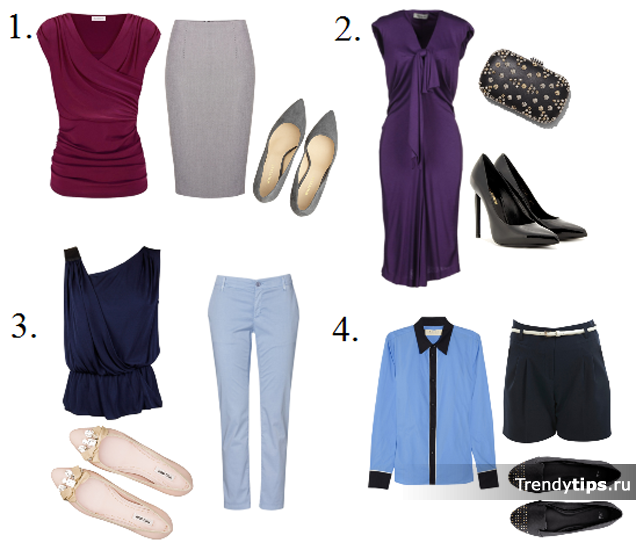
On the examples of the collage, you can see combinations for a dark winter on summer period. In the first example, the use of a dark color is closer to the face, a light gray skirt and shoes contrast in lightness with a dark blouse. In the second example, the dark color of the dress from the palette is combined with a black bag and shoes. In the third example, the dark color of the blouse contrasts in lightness with trousers and shoes. In the fourth example, there is also a contrast in lightness, a light blouse with dark trim and dark shorts and shoes. The use of dark colors and light contrast are the main principles of color combinations for a dark winter. 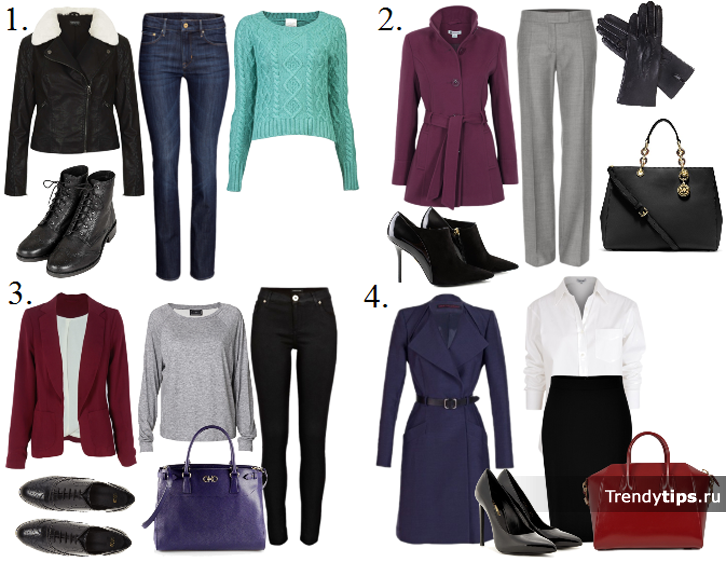
Using the examples of this collage, you can see the principles of color combinations for a dark winter on autumn-winter period.
There is no spring variegation or a smooth summer flow from color to color, but there is color severity. The contrast in lightness that I mentioned above can be seen in all examples. For example, this is a black jacket with a white collar in the first example, and light trousers and a dark coat in the second. There is a contrast in color, but it looks very restrained. In the third example, the blue color of the bag contrasts with the burgundy jacket. Of course, any combination of dark colors is good for a dark winter. But with this, I think there will be no problems. Everything is simple here.
dark autumn
Other names:
deep autumn
Color characteristics:
leading - dark, additional - warm
Associations:
deep, warm, warming, earthy, generous

J. Latour "Mary Magdalene"
In appearance, people of dark autumn are dominated by dark and warm tones. The hair is dark. Reddish, chestnut shades are more common. Eye color can be any. Brown, green, blue-green, gray-green. The skin tone is definitely warm.
Photos of people whose color type is dark autumn: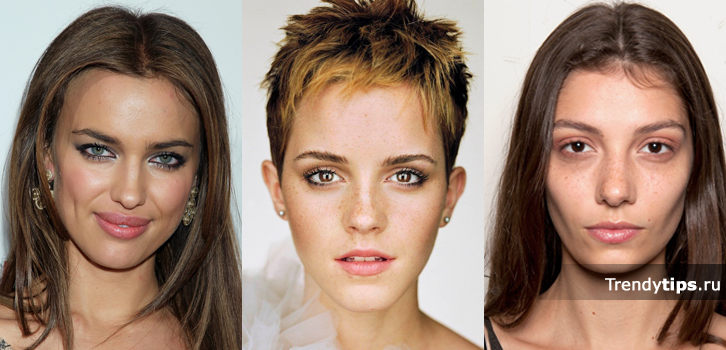

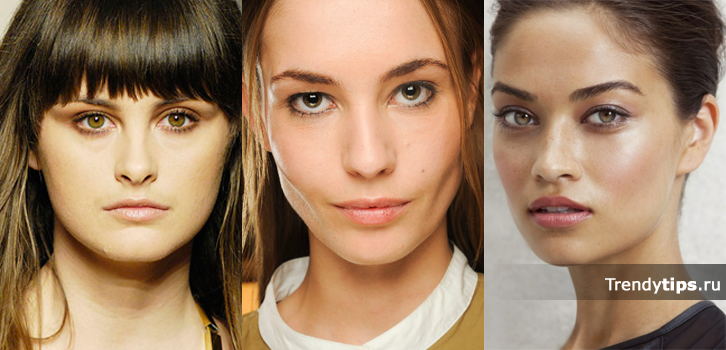
Let's look at the palette for dark autumn. It is also broken down into light, dark, medium saturation and bright colors.
Light colors
Light colors are suitable for underwear, blouses, summer and evening wear. Light colors for dark winters were icy, and for dark autumns they are warm.
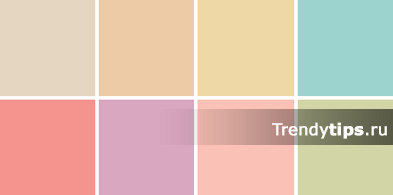
dark colors
Dark colors are well suited for coats, suits, skirts, trousers, jackets, shoes, belts, bags. They create a sense of stability, seriousness and restraint. "Native" colors for dark autumn. 
Medium saturation colors
Neutral colors are medium-dark colors of the palette, they are calm, not annoying, easily combined with other colors. 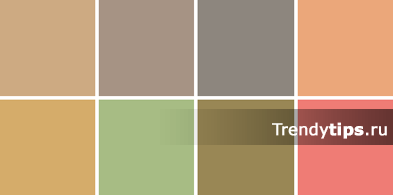
Bright colours
Bright colors are used in accessories, evening dresses, sportswear. They always attract with their color saturation. They are often used as color accents that are able to revive the outfit. 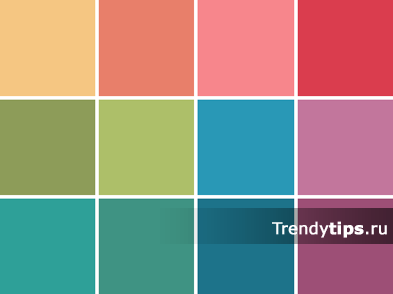
In addition to light, dark, medium saturation colors and bright colors, there are still exterior colors. They look natural.
Now with the help of the palette we will combine colors. The overall color effect for dark fall should be medium-dark to dark. If contrasts and color rigor are well suited for a dark winter, then monochrome and analog combinations are well suited for a dark autumn. Contrasting options will be richer in color than for a dark winter.
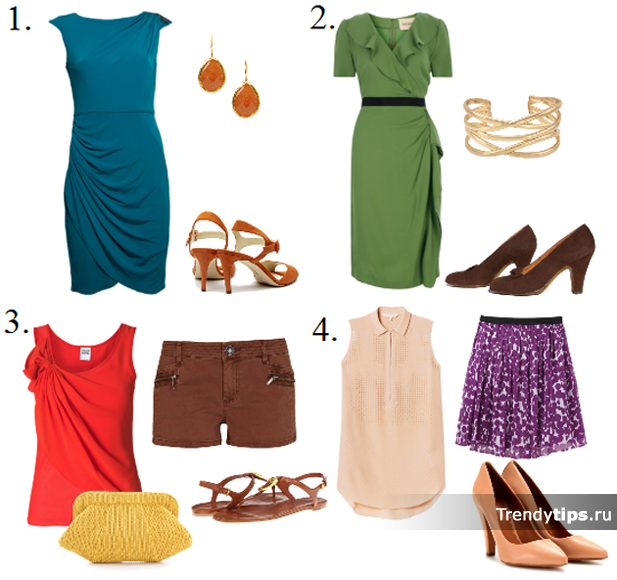
On the examples of the collage, you can see color combinations for dark autumn for the summer period. In the first example, dark autumn can afford to be brighter than dark winter, so the contrast of turquoise and orange is used here. On the second, a bright green dress is harmoniously combined with brown shoes, a gold bracelet successfully emphasizes the temperature of a dark autumn. On the third - to the top of warm red colors goes yellow bag and brown shorts and shoes. In the fourth example - to a warm skirt purple a light cream blouse and beige shoes are matched. The use of warm and dark colors, contrast in lightness are the main principles of color combinations for dark autumn. 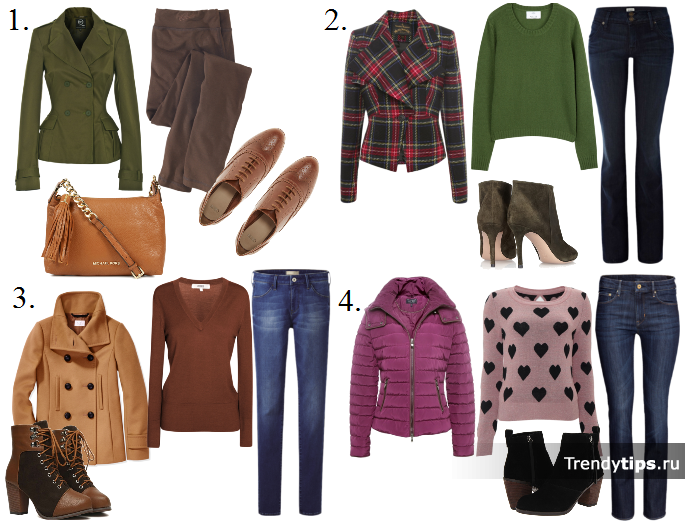
On the examples of the collage, you can see examples of color combinations for dark autumn for the autumn-winter period. In the first example, the green jacket contrasts with the orange bag. In the second example, a contrasting red-green cell. In the third example, the analog combination of beige and brown, but at the same time, there is also a contrast here - the beige-brown gamma contrasts with blue jeans. In the fourth example, there is a contrast in lightness, a dark pattern is located on the light background of the jumper.
Differences between dark winter and dark autumn
If you are in doubt between these color types, then you need to color proof the fabric. You need to look at what colors the skin tone will react to. From some colors, the face is illuminated and shines, while from others it dims. For a dark winter, dark and cold colors are suitable. For dark autumn - dark and warm.
There are also differences in color combinations. For a dark winter, combinations of serious, restrained, without variegation are suitable. This color type refers to winters, so you need to apply a contrast in lightness.
For dark autumn, richer color combinations are suitable. Monochrome and analog combinations look good here. This is because in autumn color types all colors are slightly softened. in gray, so they are not as dramatic as those of a dark winter. But contrasting combinations are also good for dark autumn, and they can be richer in color.
I hope you felt the strength and, at the same time, the restraint of a dark winter and the generosity and warmth of a dark autumn.
Do you like the dark color?
What emotions do dark winter and dark autumn evoke in you?
Read privately:
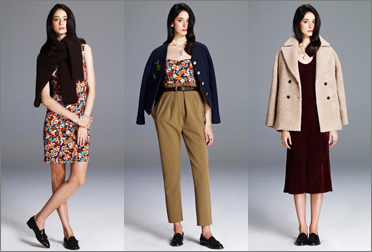 |
According to legend, the idea to divide the appearance of people into several color types belongs to Max Factor. I don't know if this is true, but whoever came up with it was really a genius. In most cases, you can determine the color type in just a few minutes, thereby making it easier to choose the color of clothes and makeup for the rest of your life (well, or at least until the hair dye helps change the color type).
Why even bother with the selection of "their" colors, they may object to me. Many people choose clothes according to the principle of “non-marking”, “fashionable” or “oh, I love this color”, and they are happy at the same time without any sophisticated scientifically based methods. So it is, designers are well aware of this phenomenon - a fairly large number of buyers rush to the color, and not to the style or, holy-holy-holy, silhouette and interesting details.
In turn, I can object that young ladies who have chosen their hearts come home and find that the color of spontaneous purchase not only does not combine with anything, it also makes the face painfully gray, aged immediately by ... twenty years. Such a magical deadening effect signals that this color is categorically contraindicated for this person, because it is discordant with his color type. But there are colors that, on the contrary, refresh the face without cosmetic procedures and make-up, giving him the ability to glow with youth and health, despite a sleepless night in a smoky club. So it’s worth spending half an hour to determine your color type and remember “your” and “not your” colors, so that purchases will only please you in the future. By the way, this is especially recommended for men, since they do not have the opportunity to use decorative cosmetics, which can sometimes reconcile a "foreign" color with the appearance of a lady.
Well, to the point. Appearance color type is a combination of skin, hair and eye color, classified by a special in a secret way. The whole variety of Caucasian faces can be divided into a very small number of color types. Today, the most common maxfactor option is four main colors(spring Summer Autumn Winter). Many stylists and makeup artists only know him because he is quite easy to work with. There are other classifications of color types (where, for example, there are five, six or ten). But we will focus on the classic, using the images of the seasons....
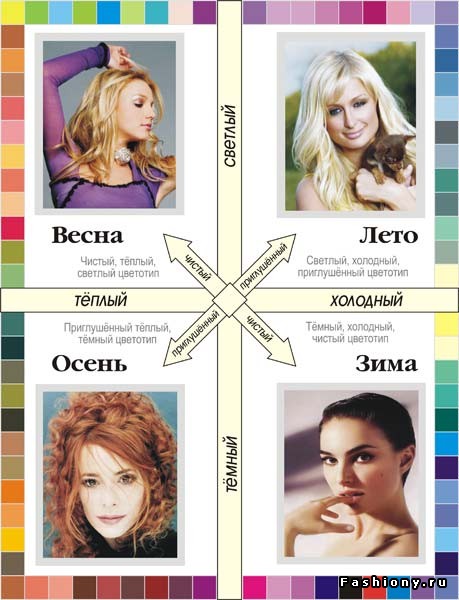
The color type is diagnosed in front of a large mirror in a bright room with walls and furniture in light neutral tones (ideally - white room). Everything bright from the field of view must be removed. Lighting should be neutral, best diffused daylight. Direct sun or yellow electric lighting is not allowed. Immediately before the diagnosis, let your eyes rest, do not look at bright objects or at the light, whether it be a lamp, monitor, TV or life outside the window. Makeup and jewelry must be removed. Clothing preferred neutral colors with open shoulders, you can undress to the waist.
You will also need pieces of fabric different colors. Get plain scarves, shawls, bedspreads, towels, diapers, clothes, cuts of material from the bins. The more flowers, the better. Do not rush to apply all this to your face in search of your ideal, first delve into the essence of the technique. And let the rags lie aside for the time being, you should not look at them once again, otherwise the foci of vision in the form of phenomena of consistent contrast will not slow down to reveal themselves. (Consistent contrast is when you look at red, then look at white or gray, and it seems green to you. I’m not lying, you can check it yourself. After a long contemplation of a color, an image of a shade complementary to this color is generated in the eye.)
To identify the color type, we must decide on three pairs of indicators. Each of the four color types has only one indicator from each pair. Here are the couples:
. light dark;
. warm - cold;
. clean - muted.
When determining pairs of indicators, we focus primarily on hair color. Skin color is an indicator rather auxiliary. And the eyes do occupy such a small area of the face that in our work their color can be neglected.
Light dark. Everything is pretty simple here. We will refer to light blondes, light and medium blond, light chestnut, light red. To the dark ones - all the rest: dark blond, brown-haired, red and brunettes. There are many times more dark color types than light ones (although modern paints for hair significantly change this proportion). Light color types are spring and summer, dark ones are autumn and winter.
Warm - cold. In determining warmth or coldness, it is important not to make a mistake. All shades of hair and skin can be either warm golden or cold ash, depending on the presence or absence of golden pigment in the hair and skin. Take a closer look at the hair, turn it around, paying special attention to the highlights. Your task is to notice the golden halo, if there is one. It can be obvious, in the case of red hair, but often the line between golden and ashy hair is very thin. This is especially true for light brown and dark brown hair. Cold hair can be yellowish or brownish (especially if the hair is dyed), but their highlight is always white, without the slightest redhead.
Skin color, freckles, moles can help you determine warmth or coldness. In warm color types, the skin also contains a golden pigment, which gives it a shade of peach, ivory, champagne, bronze, gold. Freckles and moles are also reddish. In cold color types, a network of bluish blood vessels shines through the skin, and the blush, if any, is pink with a raspberry tint. Cold skin - snow-white, bluish, pinkish, olive. Freckles and moles in cold color types are grayish-brown.
Warm types are more suited to gold, bronze, brass, copper than silver, steel and platinum. Cold is the opposite. To determine the warmth or coldness, you can try to answer the question of which metals are in harmony with your appearance.
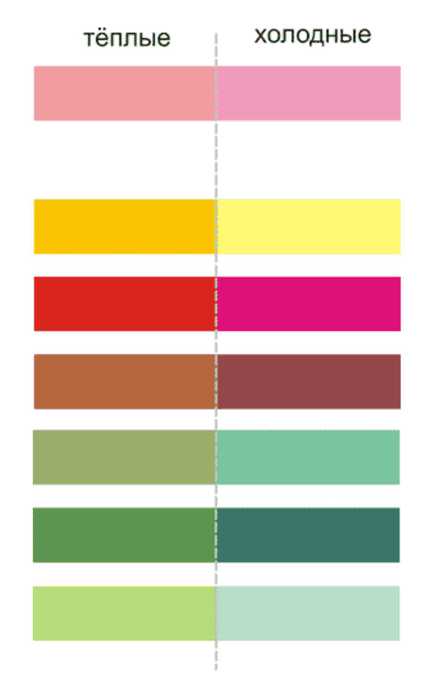
A color proof that allows you to determine the coldness or warmth is the application of two variants of pink to the face - warm shade salmon and cold a-la "Dom-2".
If something similar is lying around in your pile of rags, it’s great, if not, you can use other pairs of warm and cold nuances of the same color for color proofing.
As a last resort, practice with blue and orange of approximately the same lightness and saturation. One of a pair of colors will refresh your complexion and emphasize the color of your hair, the second, on the contrary, will be discordant with your appearance.
Warm colors go with warm color types, cold colors go with cold ones (yes, that's how simple it is).
Warm color types are spring and autumn, cold color types are summer and winter.
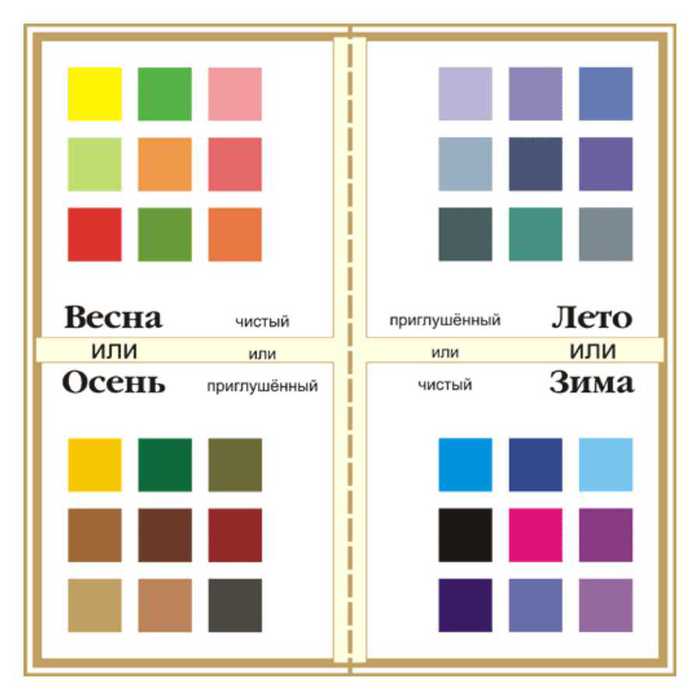
In many cases, the definition of parameters from the first two pairs is enough to identify the color type. Spring - light warm color type, summer - light cold, autumn - dark warm, winter - dark cold. The third pair (pure - muted) is used in difficult cases, to check the diagnosis, well, and for a more complete understanding of the properties of color types.
Clean - muted. These properties are determined using color proofs. Warmth and coldness must be determined in advance. If there is any doubt, spring or autumn color type, warm clean and muted tones are used, if the choice is between summer and winter, cold clean and muted.
Pure color types - spring and winter, muted - summer and autumn.
When the color type is determined, choosing colors is very simple. Each color type is suitable for colors that match its properties. For example, a light warm pure color type (spring) goes with light warm pure shades. In my next posts, I will try to describe everything in more detail ...
And one more necessary reservation - it cannot be said that some color does not suit this color type. Certain shades of color may not go, but the entire spectrum in various nuances is represented in the color map of the color type. There are shades of red for each color type, shades of green, blue, yellow, purple, etc.
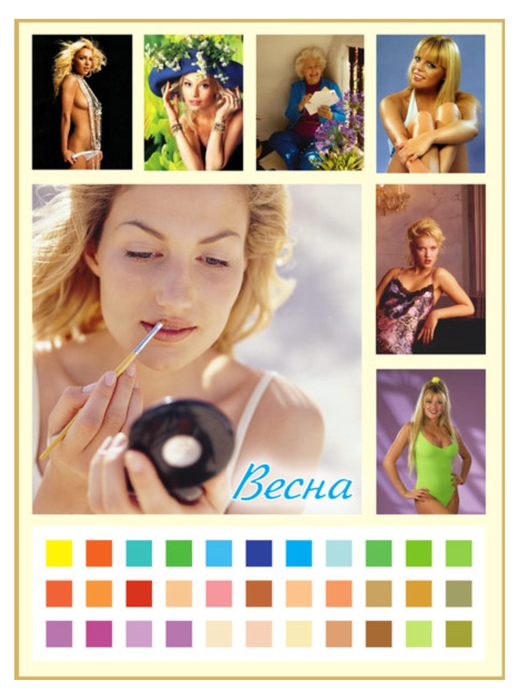
Spring- light warm clean color type. And the colors suit him light, warm and clean. Spring palette gives the impression of freshness. Yellow dandelions and tulips green colors young foliage, turquoise and bright blue tones of water and sky - this is the association that arises with the word "spring".
Spring has golden blonde, honey-blond or red hair, light, often well-tanned skin, a bright peach blush. People of the spring type blush easily. The eyes are light - turquoise, greenish-amber, aquamarine, blue (without gray shade), cornflower blue, occasionally golden brown. Spring type hair is never darker than honey. Spring women - Elena Korikova, Anna Semenovich, Britney Spears at their best. This is the rarest color type. The key impression that spring type people make is freshness and cleanliness.
Cheerful caramel tones, warm pastels, light orange, coral and tomato shades of red, cream and golden beige, light brown, pure golden yellow, yellow-green, olive, light reddish-violet are well suited for the clear delicate appearance of spring women. A noble color can form the basis of a business wardrobe. camel hair. Instead of snow-white, it is better to use color eggshell, ivory, vanilla. Gray and black colors, complex or heavy tones are contraindicated for this color type.
Spring or summer?
To determine whether a fair-haired person belongs to the spring or summer type, a color test can be performed. For example, compare which blue color is best in harmony with the appearance - pure cornflower blue or classic indigo denim. Radiant spring requires intense cornflower blue, muted tones denim seem pale and dirty next to this bright appearance. With the tenderness of the summer type, on the contrary, worn jeans harmonize well, and intense colors clog the appearance, make the eyes pale, and the hair dull.
In summer, eyebrows, freckles, moles never have a reddish tint, they are ashy, grayish. Lip color is more cold pink than warm red. Summer blush is also cold raspberry, unlike spring peach.
Spring or autumn?
Spring-type hair is never darker than honey-blond, and its hue is golden, without a reddish copper tint. Spring is never dull, dull, calmly blond, it is always a radiant, intense golden appearance. Spring, unlike autumn, tans easily and blushes easily. Autumn, compared with spring, seems a little pale, people of the autumn type do not have a blush on their cheeks.
You can do a color test - apricot against red-brown. Dark brown, perfect for autumn, too dark for spring. Apricot, on the contrary, well emphasizes the spring radiance, but for autumn it is too primitive, it seems vulgar.
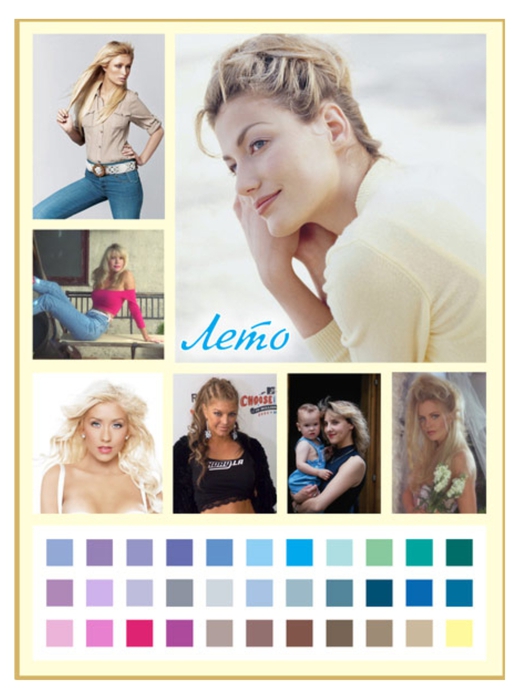
Summer- light cold muted color type. Imagine a summer landscape. The greenery burned out in the sun and covered with a layer of dust, the horizon in a bluish haze, bluebells, cornflowers and chicory blossomed. It's hot, and drawn to blue, blue, greenish water. Periodically, rains and thunderstorms come, and the sky turns purple, lilac, gray. The summer color type is light, cold and muted, giving the impression of tenderness and tranquility.
The hair of people of the summer type is dull, ashen, from light, almost white, to dark blond. Many brown-haired men, even rather dark ones, also belong to the summer type. The range of lightness here is wider than that of the spring type. Even brownish and yellowish shades of summer-type hair do not have a golden or copper sheen. The summer complexion is characterized by a cold basic tone, noble and refined. Skin options: pale porcelain, light transparent with translucent blood vessels of cold Pink colour, light greyish-olive. As a rule, the summer type tans well, the tan is brownish-olive. The eyes of the summer type are gray, blue-gray, gray-blue, gray-green, gray-brown. The look seems somewhat detached, smoky. Typical representatives of the summer type are Princess Diana, Gwyneth Paltrow, Paris Hilton.
The summer color type is ideal for lilac, gray, muted light blue and blue tones. Green - willow, gray-green color of sagebrush or reverse side coltsfoot leaf, bluish-green, blue-green. Reds are light raspberry and wine shades. Gray-yellow and soft lemon shades. White with a grayish tint natural wool. Black, too dark or warm colors(especially orange) are contraindicated for this color type.
Summer or autumn?
People with blond, dull hair often cannot determine their color type. Indeed, it is not always obvious at first glance, golden hair or ashy. With full confidence, a color proof can determine the difference in such cases. You can compare, for example, the color of rust and blue-gray. Blue-gray will perfectly emphasize the smoky look of the summer type, shade ashy hair. The color of rust will make the hair dull, the skin - sluggish and lifeless. On the contrary, the autumn type will look advantageous in rusty brown, and gray will be dissonant with delicate golden skin.
Another sign of the summer type is a persistent tan. Autumn quickly burns in the sun, the tan is very light and does not last. There are differences in the whites of the eyes - in summer they are milky white or cream, which creates the effect of a cloudy, smoky look, while in autumn they are bright white or bluish, which makes the look radiant. Summer eye color is always calm, with a grayish tinge, autumn eyes are golden green and brown, pure blue and turquoise, occasionally blue.
Summer or winter?
Brown hair with ashy hair can be attributed to both summer and winter. The key indicator in this case is the level of contrast. Winter always has dark eyelashes and eyebrows, bright blue, green or dark Brown eyes with pure protein that are secreted on the face. In the summer type, the lightness ratios of the skin, eyebrows and eyelashes are rather nuanced, the eyes are calm grayish, the look is smoky, the white of the eyes is not bright.
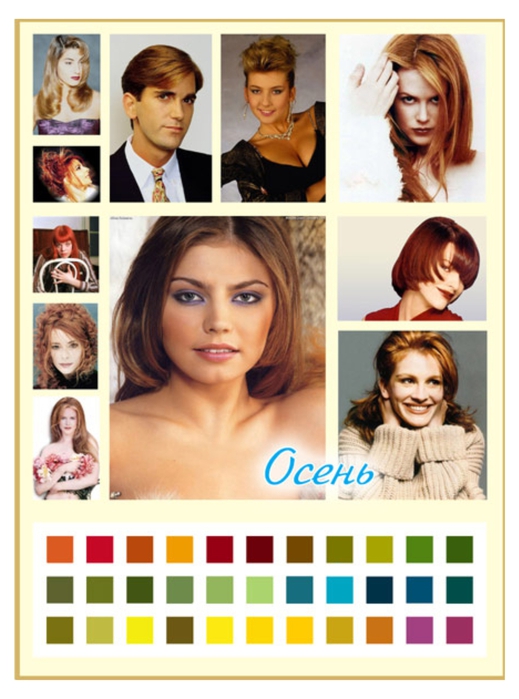
Autumn- dark warm muted color type. The rich palette of the autumn landscape is the colors of withering foliage, withered grass, wet bark, vegetables and fruits. Autumn tones are soft, complex. The impression of the autumn color type is luxury and nobility.
The autumn type is very diverse. Hair color is golden blond, all shades of red, golden chestnut, including very dark. Champagne, ivory, golden beige, peach skin. The autumn type does not have the bright blush inherent in spring, so the skin may appear pale. The autumn type does not tan well, the sun in most cases causes only redness. Freckles in autumn are quite common. Many people of the autumn type in childhood had blond hair, which darkened with age. The eyes are bright, with pure dazzling white or bluish protein, golden green, hazel green, turquoise, blue, hazel, topaz, golden brown, dark brown. Women of the autumn type - Julia Roberts, Mylene Farmer, Alla Pugacheva.
Perfect Colors for the autumn type - red, rusty, golden, copper, brown. Colors of spices are good: curry, cinnamon, mustard. Yellow - corn, brass. Red - garnet, brownish red, burgundy. Greens are faded and complex - marsh, khaki, moss, olive, brownish. It is very difficult to choose a blue color for the autumn color type. Muted turquoise, aquamarine (closer to green than blue), deaf black oil will do. It is important that the colors are not too light, pastel, or pure. Black and gray categorically do not go to the autumn type.
Autumn or winter?
Owners of dark brown, almost black hair with a reddish tint can be mistakenly attributed to the winter type. A color test is called to help determine the type. For example, you can take brown and ultramarine. blue colors winters are too icy for the dark autumn type, they are more suited to the colors of the autumn earth. Conversely, complex browns appear muddy next to the clean, contrasting looks of winter.
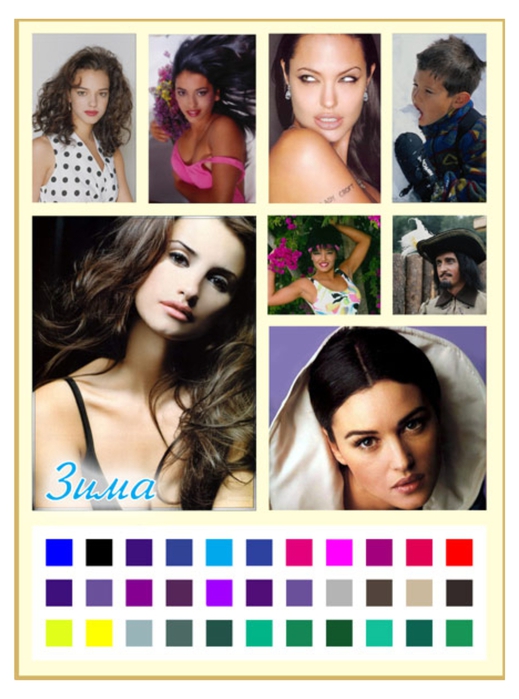
Winter- dark cold pure color type. winter nature replete with contrasts. Silhouettes of trees, deep blue shadows on the snow, bright blue and even blue-violet sky, blue ice, scarlet berries of mountain ash, viburnum, hawthorn blacken against the background of white snow. The sky turns a deep crimson at sunset. The overall impression is clarity and contrast. The winter color type is very bright. Its colors are cold and pure, extremely intense.
In winter, blue-black or ash-brown hair with a bluish tint. There is no reddish tint at all. Hair dark from childhood, their color does not change. The skin is either snow white, porcelain, or olive brown. The skin is able to tan well. The whites of the eyes are dazzlingly bright, clean. The contrast between the iris and proteins is high. The eyes are brown, black, blue, violet, bright green, ice-colored, hazel. Representatives of the color type are Penelope Cruz, Monica Belucci, Angelina Jolie.
Winter is the only color type that definitely suits black. White for the winter type is dazzling, with blue. The colors of winter are very catchy - scarlet, crimson, ultramarine, lavender, fuchsia, cornflower blue. Color combinations are contrasting in lightness and tone - white with black, ultramarine with lemon, black with red. It is interesting that the black and red combination is typical for the costume of Spain, where almost all the inhabitants are of the winter type. Winter is silver, silvery shades of gray, green, blue. Shades close to black look great - black-green, black-purple, black-blue, black-brown. Pastels do not suit winter, they look weak and pale next to such an outstanding appearance.
And finally, you still have not determined your color type - one more classic version proofing. Gotta get four shades yellow color: Egg yolk (warm clear), delicate lemon yellow (cold muted), orangey-brown yellow (warm muted), and juicy neon yellow (cold clear). Shades of yellow are applied to the face, looking for one that suits the appearance more than others. The same trick can be done with four shades of green, red, etc. This is how a professional proofing is done.
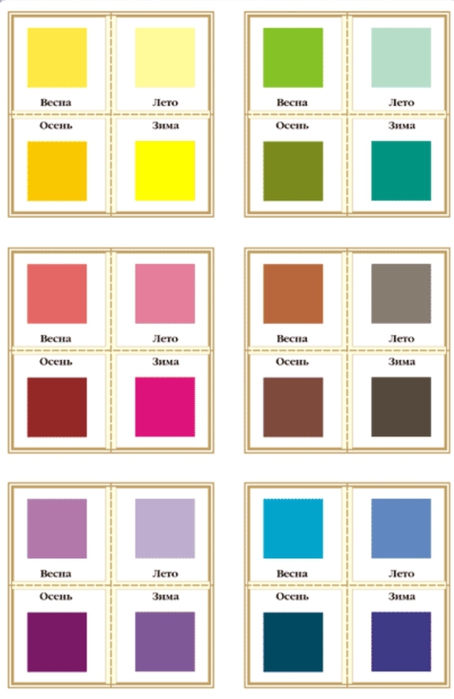
PS: Unfortunately, I can’t indicate the sources of information, I collected it from different sites, and quite a lot of time has already passed ....
